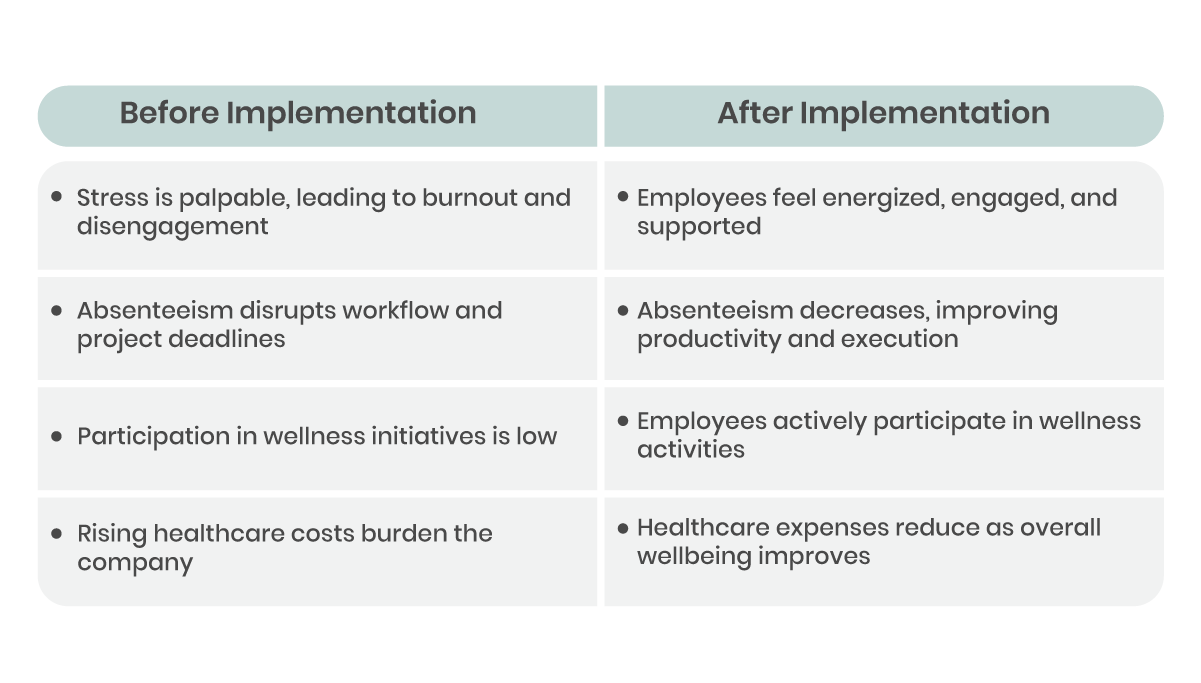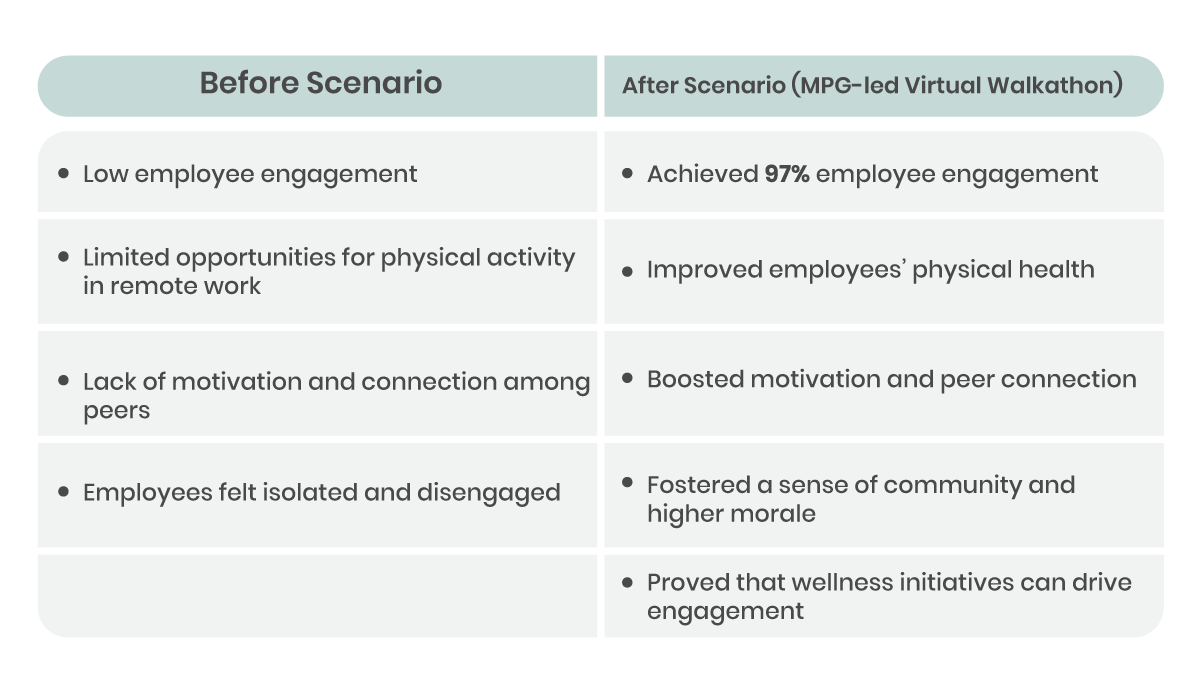Corporate Wellness Program Proposal: Step-by-Step Writing Guide
Let's be honest: convincing your boss to invest in a corporate wellness program can feel like an uphill battle. But crafting a winning proposal for an employee wellness program doesn't have to be daunting.
Most wellness proposals fail not because the programs are bad, but because they don't speak the language of business decision-makers. Your proposal isn't just about employee health; it's about organizational performance, cost savings, and competitive advantage.
This is where a well-crafted corporate wellness program proposal comes in. It's your chance to showcase the value of investing in employee well-being and secure your support.
This guide will walk you through exactly what to write in each section to create a compelling case that executives can't ignore.
Ready to get started? Download our free template and follow along:
Download Your Free Corporate Wellness Program Proposal Template
Pre-Proposal Checklist
Preparing a successful proposal for a wellness program requires a solid foundation. Here's a simple, three-step guide to help you build a compelling case.
1. Gather Your Evidence
Survey employees to understand their health needs, interests, and stress levels.
Analyze company data on sick leave, absenteeism, and turnover to find problem areas.
Interview key people in HR and leadership to get their perspective.
2. Set Your Goals and Do Your Homework
Create SMART goals that are Specific, Measurable, Achievable, Relevant, and Time-bound.
Research what other companies are doing successfully.
Identify potential resources and get a rough idea of costs.
3. Tailor Your Pitch
Know your audience. Whether it is the CEO, the finance team, or HR?
Focus on what they care about most, like ROI for finance or employee retention for HR.
How to Structure and Write Your Corporate Wellness Proposal

Writing a compelling wellness proposal is more than just putting together a document. It's crafting a story that convinces stakeholders to invest in employee well-being. Here's exactly what to include in each section:
1. Executive Summary: Lead With Business Impact
Your executive summary isn't a recap; it's your elevator pitch on paper. Start with the business problem, not the wellness solution.
What to write:
-
Lead with a compelling statistic about your industry or company size
-
State your proposed solution in one clear sentence
-
Include 2-3 key benefits with specific numbers when possible
-
End with your budget request and expected ROI
Example opening: "Companies with wellness programs report a 25% reduction in absenteeism and a 30% increase in employee productivity. We propose implementing a comprehensive wellness initiative that will address our current challenges with stress-related absences while positioning us as an employer of choice in our competitive market."
Keep it to one page maximum. Decision-makers should understand your entire proposal just from reading this section.
2. Introduction: Set the Context
This isn't where you dive into program details. It's where you establish credibility and urgency.
What to include:
-
Brief overview of why wellness matters now (post-pandemic workplace changes, labor market competition, rising healthcare costs)
-
Your company's current position and why this timing makes sense
-
What success looks like for your organization specifically
-
Think of this as setting the stage before you present the problem.
3. Problem Statement: Make It Personal and Urgent
Here's where many proposals fall flat. They use generic industry statistics instead of making the problem real for their specific organization.
How to craft this section:
-
Start with a scenario: Paint a picture of what's happening now. For example, try to imagine this: your team is facing constant project delays due to unexpected absences. Stress at work is mounting, productivity is plummeting, and employee morale is at an all-time low.
-
Back it with data: Use both industry stats and internal data when possible. According to research, there is a parallelism between absenteeism and poor employee health. The CDC reports that the average employee takes nearly 8 sick days annually, with stress and burnout being major contributors.
-
Connect to costs: Don't just mention health issues, translate them into business impact. For example, according to ComPsych, mental health-related leaves of absence surged by 33% in 2023 compared to 2022 and have increased by 300% since 2017.
4. Program Goals and Objectives: Use the SMART Framework

Vague goals kill proposals faster than budget concerns. Your objectives need to be so specific that success is undeniable. Here's how you can use the SMART framework (Specific, Measurable, Achievable, Relevant, Time-bound) to define impactful objectives:
- Be Specific:
-
❌ "Improve employee health."
-
✅ "Reduce the number of employees reporting high levels of stress by 20% within the next quarter."
-
"Increase employee engagement." ❌
-
"Increase employee participation in wellness activities from XYZ% to XYZ% within XYZ months." ✔
- Make It Measurable:
Ensure you can track participation rates, absenteeism rates, healthcare costs, and engagement scores through employee surveys, focus groups, or biometric screenings (if applicable).
- Keep It Achievable:
Don't promise miracles. Set realistic targets based on your organization's size and current baseline. If you're starting from zero participation, aiming for 40-50% engagement in year one is more credible than promising 85%.
- Stay Relevant:
Align every goal with your company's strategic objectives. How does improving employee well-being contribute to the company's mission? Include case studies showcasing how other companies have thrived after implementing employee wellness initiatives, especially organizations similar to yours.
- Set Time Boundaries:
"Increase employee participation in fitness activities by 35% within the next 12 months" gives stakeholders a clear timeline and expectation.
5. Program Description/Initiatives: Focus on Experience, Not Features
Don't just list what you'll offer, describe what the employee experience will look like and how it addresses the problems you've identified.
Structure this section by impact area:
-
Physical wellness initiatives: fitness challenges, on-site fitness options, ergonomic assessments
-
Mental health support: stress management workshops, mindfulness program, EAP expansion
-
Nutritional guidance: healthy eating workshops, nutrition consultations, cafeteria improvements
-
Work-life balance: flexible scheduling support, time management training, family wellness events
For each initiative, explain not just what it is, but why it matters for your specific workplace challenges.
6. Implementation Plan and Timeline: Show You've Thought This Through

A detailed timeline shows you're serious about execution, not just ideas.
Break it into phases:
Phase 1: Assessment and Planning (2-4 weeks)
-
Conduct employee wellness surveys and focus groups
-
Analyze current health data (if available)
-
Finalize program customization
Phase 2: Program Design and Setup (4-6 weeks)
-
Develop program materials and a communication strategy
-
Set up technology platforms (like Vantage Fit for tracking and engagement)
-
Train wellness coordinators and key staff
Phase 3: Pilot Launch (6-8 weeks)
-
Soft launch with volunteer groups
-
Gather initial feedback and make adjustments
-
Build momentum through success stories
Phase 4: Full Implementation (Ongoing)
-
Company-wide rollout with communication campaign
-
Regular programming and wellness challenges
-
Continuous feedback collection and program refinement
Phase 5: Evaluation and Optimization (6-12 months)
-
Comprehensive impact assessment
-
ROI analysis and reporting to leadership
-
Program adjustments based on results
7. Give One Before And After Scenario
To convince your organization of the importance and relevance of a wellness program, you must first sell them on the idea of its benefits. So how do you plan to accomplish that? Ideally, you should present them with a hypothetical implementation scenario (before and after). Let's take a quick look-

8. Back Up With Case Study Example
A well-designed wellness program can transform your workplace. Let’s take inspiration from the MindPoint Group (MPG) Virtual Walkathon, powered by Vantage Fit.

This real-world example shows how a simple, yet effective wellness program can create a healthier, happier, and more engaged workforce.
9. Budget/Pricing Breakdown: Be Transparent and Strategic
Nothing kills a proposal faster than budget surprises. Break down every cost category with clear explanations.
- Personnel Costs:
-
Wellness Coordinator (part-time): $X, XXX annually
-
Guest instructors and workshop leaders: $XXX per session
-
Health professionals for specialized programming: $X, XXX
- Technology and Platform Costs:
-
Wellness platform subscription (e.g., Vantage Fit): $X per employee per month
-
Fitness tracking devices (subsidized): $XXX total
-
Program management software: $XXX annually
-
Program Materials and Resources:
-
Educational materials and printing: $XXX
-
Workshop supplies and equipment: $X, XXX
-
Marketing and communication materials: $XXX

- Incentives and Engagement:
-
Participation rewards and prizes: $X, XXX annually
-
Challenge prizes and recognition: $XXX quarterly
-
Team building and special events: $X, XXX
-
Contingency Fund (10%): Always include this for unexpected costs or program adjustments.
Present costs as "investment per employee per month" ($XX/employee/month) to make large numbers feel more manageable.
10. Vendor Selection: Justify Your Recommendations
If you're recommending specific vendors or platforms, explain your selection criteria clearly.
What to include:
-
Comparison of 2-3 options you evaluated
-
Key features that align with your goals
-
References or case studies from similar organizations
-
Integration capabilities with existing systems
-
Scalability for future growth
11. Measurement and Evaluation: Prove Success Before It Happens
Show exactly how you'll track success and when you'll report back.
- Key metrics to track:
-
Participation rates by program component
-
Absenteeism and sick leave usage
-
Employee health metrics (biometric improvements, health risk assessments)
-
Employee satisfaction and engagement scores
-
Healthcare cost trends
-
Productivity indicators
- Reporting schedule:
-
Monthly participation reports
-
Quarterly progress updates
-
Semi-annual comprehensive assessments
-
Annual ROI analysis
12. Expected Outcomes and ROI: Be Conservative But Compelling
Base your projections on real data from similar organizations, not best-case scenarios.
Present both hard and soft ROI:
1. Hard ROI (quantifiable):
-
Reduced healthcare costs: Based on industry averages, expect a 2-5% reduction in the first year
-
Decreased absenteeism: Target 10-15% reduction in stress-related absences
-
Lower turnover costs: Even a 5% improvement in retention saves significant replacement costs
2. Soft ROI (valuable but harder to quantify):
-
Improved company culture and employer brand
-
Higher employee engagement and job satisfaction
-
Enhanced recruitment capabilities
-
Better team cohesion and workplace relationships
13. Team & Resources: Show You Have the Right People
Identify who will lead this initiative and what support they'll need.
Key roles:
-
Executive sponsor (crucial for organizational buy-in)
-
Program manager/wellness coordinator
-
HR partnership for policy integration
-
Communications team for promotion and engagement
-
Finance collaboration for tracking and reporting
14. Call to Action: Create Urgency Without Pressure
End with a clear next step that feels natural, not pushy.
What to include:
-
Specific timeline for decision-making
-
Next steps if approved (who does what when)
-
Contact information for questions
-
Offer to present to the leadership team or answer questions
Example: "The competitive job market means we can't afford to wait on employee wellness. Companies implementing programs now are seeing immediate improvements in engagement and retention. I'd welcome the opportunity to present this proposal to the leadership team and answer any questions. Our recommended start date of [specific date] would allow us to launch before our busy season, maximizing both participation and impact."
Avoid These Corporate Wellness Program Proposal Pitfalls
Even well-intentioned proposals can fail due to common mistakes. Here are the biggest traps to avoid:
1. Leading with Features Instead of Business Outcomes
-
The mistake: "Our program includes yoga classes, lunch-and-learns, and fitness tracking."
-
The fix: "Our program addresses our xyz% absenteeism rate and rising healthcare costs through targeted stress reduction and preventive health initiatives."
2. Using Generic ROI Calculations
-
The mistake: Copying industry-wide statistics without context for your organization.
-
The fix: Use your actual baseline data (current healthcare costs, absenteeism rates, turnover costs) to project realistic improvements.
3. Forgetting Implementation Concerns
-
The mistake: Focusing only on program benefits without addressing logistical challenges.
-
The fix: Acknowledge potential obstacles and present your solutions upfront.
4. Making It All About Health
-
The mistake: Positioning wellness as just a "nice to have" employee benefit.
-
The fix: Frame every element in terms of business performance, competitive advantage, and organizational goals. Make sure your approach is holistic.
5. Overwhelming with Options
-
The mistake: Proposing several different program components in year one.
-
The fix: Start with 3-4 high-impact initiatives and plan for expansion based on success.
6. Ignoring Company Culture
-
The mistake: Proposing programs that don't fit your workplace personality.
-
The fix: Tailor every suggestion to your organization's existing culture and values.
What to Do When Your Proposal Gets Initial Rejection

Rejection isn't the end. It's valuable feedback. Here's how to turn a "no" into a "not yet" or even a "yes."
- First, understand the real objection:
-
Budget concerns usually mean "show me better ROI projections."
-
Timing issues often mean "start smaller or propose a pilot."
-
Skepticism about effectiveness means "provide more proof and references."
- Your response strategy:
-
Ask for specifics: "What would need to change for this to be a yes?"
-
Offer a pilot program: Propose a 3-month trial with 2-3 initiatives and clear success metrics
-
Find a champion: Identify someone in leadership who's personally interested in wellness
-
Start grassroots: Begin with low-cost, high-visibility initiatives to build momentum
-
Revisit timing: Sometimes it's just not the right budget cycle or business focus
Remember, many successful wellness programs started as pilot initiatives that proved their worth before expanding.
Summing it up
A strong corporate wellness proposal isn't about perfection. It's about showing leaders how wellness drives business results. Focus on outcomes, outline clear implementation, and address concerns upfront.
Remember, executives don't buy "wellness programs"; they invest in performance gains delivered through employee well-being.
FAQs
1. What is a corporate wellness program proposal?
A formal plan outlining workplace wellness initiatives, budgets, timelines, and expected outcomes to secure leadership approval.
2. How can I get supporting data if no health metrics are tracked?
Use sick leave, turnover, surveys, and healthcare usage. Add a short anonymous wellness survey and industry benchmarks.
3. How long does it take to write and get approval?
Writing: 2–4 weeks. Approval: 2 weeks (small firms) to 3–6 months (large firms). Early buy-in helps.
4. How long should it be?
8–12 pages plus appendices, with a 1–2 page executive summary.
5. What if a past program failed?
Acknowledge it, explain why, and show how your plan fixes those gaps (e.g., leadership support, better fit, employee input).




